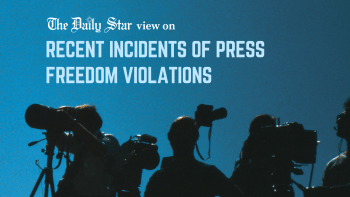The unspoken trauma of journalists

As we observe the World Day for Safety and Health at Work, attention turns to garment workers, factory safety, and workplace reforms. In Bangladesh, this day also invariably brings back haunting memories of numerous disasters, including the Rana Plaza collapse, which claimed more than 1,100 lives. It is a day dedicated to workers' rights, safety, and remembrance.
But there is another group of workers who, while not inside factories or construction sites, also live through trauma, violence, and suffering. Their pain, however, is largely invisible, unacknowledged, and rarely addressed because, typically, their workplace extends beyond the concrete walls of buildings. As such, generic workplace definitions and regulations do not apply to journalism. They witness pain, often at the frontlines of disasters, tragedies, and conflicts. Yet in Bangladesh, while we cover trauma, our own trauma remains undocumented, untreated, and mostly undiagnosed.
Consider the July 2016 Holey Artisan Bakery massacre that changed Dhaka forever. As the horror unfolded in the heart of Dhaka's diplomatic zone, reporters scrambled to cover the siege. They thronged the cul-de-sac, standing there for hours in confusion and chaos, fearing that they too might be caught in crossfire. The ones who covered the attack vividly remember the smell of gunpowder and the sound of screams. The image of bodies being carried out, and the wails of family members, remain etched in their memory.
"We stood outside for more than 14 hours. When the shooting started, we all crouched behind walls, praying. I had to write a breaking story while shaking inside," said one photojournalist, requesting not to be named. "After that, I couldn't sleep for weeks. The sound of gunfire haunted my dreams."
A similar wave of trauma swept through the media fraternity during the Rana Plaza tragedy in 2013. Reporters watched as rescuers pulled mangled bodies out of the debris, many of them children and young women. For days, journalists worked without sleep, consoling bereaved relatives, and narrating scenes too horrific for most people to imagine.
"I still remember the sound a lifeless body made when it was being pulled out. I smell dust and blood when I close my eyes," said a senior reporter who covered the Rana Plaza incident. "I had nightmares for months. Nobody ever asked how I was doing."
More recently, in 2024, journalists covered a violent conflict when the streets of Dhaka and other major cities turned into battlegrounds. Law enforcers and Awami League members turned on quota reform protesters in July and went on a shooting spree. Hundreds of students and ordinary citizens were killed, thousands more were injured. The UN estimates at least 1,400 deaths. At least five journalists were killed, and many were injured. Those who managed to make it through continue to cope with their trauma. Some will probably never recover from it.
Unlike aid workers or emergency responders, journalists have little institutional recognition when it comes to mental health support or trauma care. In Bangladesh, there is hardly any form of psychological assistance, debriefing sessions, or even basic mental health leave. There are no safe space to talk, heal, or process the emotional toll of the job.
Yet the reality is, the trauma builds up. A journalist—be it a reporter, sub-editor, or photographer—covering a fire one day, a rape case the next, and a bomb threat later in the week, carries all those images internally. Over time, the mind grows tired, the heart heavy.
The impact of vicarious trauma is well-documented globally. Journalists may develop post-traumatic stress disorder (PTSD), suffer from depression, anxiety, insomnia, or emotional numbness. Some develop addictions; others quit the profession entirely.
Yet, in Bangladesh, the stoic culture of "just carry on" dominates. There is almost a macho pride in being unfazed, even when the heart is breaking.
The first step is simple yet powerful: acknowledge that journalists, too, are workers. And they, too, deserve safety, health, and dignity at work.
The need for mental health leave, meaning days off specifically for psychological recovery after covering traumatic events, should be recognised. Just as firefighters are debriefed and given downtime after a big operation, journalists should be also be allowed to rest. Media organisations can provide access to professional counsellors so that journalists have the option to avail therapy sessions after covering events like murders, suicides, rape cases, and disasters. Newsrooms should normalise counselling, availing which should not be perceived as weakness but as a strength.
Journalists, especially those on crime and disaster beats, should be trained on how to identify the signs of trauma in themselves and others. This would help them cope, flag signs of distress or acute stress, and more sensitively cover the trauma of victims and survivors.
Media outlets and journalist unions can establish peer support groups, where journalists can meet periodically to talk, share experiences, and decompress. Sometimes, healing begins simply by talking to someone who understands.
The Press Council of Bangladesh, journalist associations like the Bangladesh Federal Union of Journalists (BFUJ), etc must actively push for national-level guidelines recognising journalism as an emotionally high-risk profession. The information ministry can collaborate with health experts to launch media mental health initiatives.
Recognising trauma is not just a matter of empathy, it impacts the quality of journalism itself. A burnt-out, emotionally fatigued journalist cannot ask the right questions or connect with the people. Trauma clouds judgement, kills curiosity, and numbs the storytelling instinct.
Moreover, untreated trauma leads to high dropout rates, especially among women journalists who face added layers of emotional stress. When the brightest and most compassionate voices leave journalism due to pain and burnout, democracy suffers.
It is also time to change the narrative. Journalists are not mere bystanders in national tragedies—they are active participants, navigating between chaos and deadlines. We document grief so others can understand it. We hold microphones in bloodied spaces. We stare at trauma, then look at the camera and hand it over to the anchor in the studio with a simple, "Back to you." The trauma, however, stays with us.
But who turns the camera on us?
So, on this World Day for Safety and Health at Work, let us expand our lens. Let us remember the survivors of Rana Plaza. Let us remember the victims of Holey Artisan. But let us also remember those who documented their stories, often at the cost of their own mental well-being.
Md Abbas is staff reporter at The Daily Star. He can be reached at [email protected].
Views expressed in this article are the author's own.
Follow The Daily Star Opinion on Facebook for the latest opinions, commentaries and analyses by experts and professionals. To contribute your article or letter to The Daily Star Opinion, see our guidelines for submission.

 For all latest news, follow The Daily Star's Google News channel.
For all latest news, follow The Daily Star's Google News channel. 






Comments